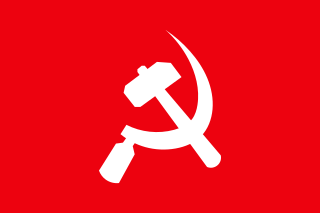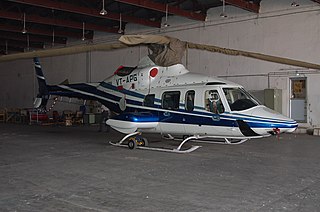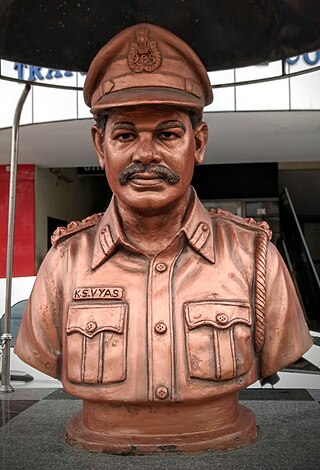
The Communist Party of India (Maoist) is a banned Marxist–Leninist–Maoist communist political party and militant organization in India which aims to overthrow the "semi-colonial and semi-feudal Indian state" through protracted people's war. It was founded on 21 September 2004, through the merger of the Communist Party of India (Marxist–Leninist) People's War (People's War Group) and the Maoist Communist Centre of India (MCCI). The party has been designated as a terrorist organisation in India under the Unlawful Activities (Prevention) Act since 2009.
The Balimela Reservoir is located in Malkangiri district, Odisha, India on the river Sileru which is a tributary of the Godavari river. The gross storage capacity of Balimela reservoir is 3610 million cubic meters.
The red corridor, also called the red zone or according to the Naxalite–Maoist parlance the Compact Revolutionary Zone, is the region in the eastern, central and the southern parts of India where the Naxalite–Maoist insurgency has the strongest presence. It has been steadily diminishing in terms of geographical coverage and number of violent incidents, and in 2021 it was confined to 25 "most affected" and 70 "total affected" districts across 10 states in two coal rich, remote, forested hilly clusters in and around Dandakaranya-Chhattisgarh-Odisha region and tri-junction area of Jharkhand-Bihar and-West Bengal.

The Naxalite–Maoist insurgency is an ongoing conflict between Maoist groups known as Naxalites or Naxals and the Indian government. The influence zone of the Naxalites is called the red corridor, which has been steadily declining in terms of geographical coverage and number of violent incidents, and in 2021 it was confined to the 25 "most affected" locations, accounting for 85% of Left Wing Extremism (LWE) violence, and 70 "total affected" districts across 10 states in two coal-rich, remote, forested hilly clusters in and around the Dandakaranya-Chhattisgarh-Odisha region and the tri-junction area of Jharkhand, Bihar, and West Bengal. The Naxalites have frequently targeted police and government workers in what they say is a fight for improved land rights and more jobs for neglected agricultural labourers and the poor.

Patel Sudhakar Reddy, aliases Suryam, Damodar, and Venkatesh, was a leader of the central committee of the Communist Party of India (Maoist).

The 2009 Andhra Pradesh helicopter crash occurred on 2 September 2009 near Rudrakonda Hill, 40 nautical miles (74 km) from Kurnool, Andhra Pradesh, India. The helicopter was a Bell 430 helicopter owned by the Andhra Pradesh Government, and registered VT-APG. Fatalities included Y. S. Rajasekhara Reddy, the Chief Minister of Andhra Pradesh.
This is a timeline of the 1967–present Naxalite–Maoist insurgency in eastern India.
Communist Party of India (Marxist–Leninist) People's War, usually called People's War Group (PWG), was an underground communist party in India. It merged with the Maoist Communist Centre of India to form the Communist Party of India (Maoist) in 2004. Muppala Lakshmana Rao ('Ganapathi') was the general secretary of the party. The ideology of the party was Marxism-Leninism-Maoism.
Operation Green Hunt is the name used by the Indian media to describe the "all-out offensive by paramilitary forces and the states forces" against the Naxalites. The operation is believed to have begun in November 2009 along five states in the "Red Corridor."
The April 2010 Dantewada Maoist attack was an 6 April 2010 ambush by Naxalite-Maoist insurgents from the Communist Party of India (Maoist) near Chintalnar village in Dantewada district, Chhattisgarh, India, leading to the killing of 76 CRPF policemen and 8 Maoists — the deadliest attack by the Maoists on Indian security forces.

Greyhounds is a police special forces unit of the Andhra Pradesh and Telangana Police departments in India. Greyhounds specialises in counter-insurgency operations against Naxalite and Maoist terrorists.
Cherukuri Rajkumar was an Indian politician who was the spokesperson and one of the seniormost members of the Central Politburo of the banned Maoist group Communist Party of India (Maoist). On 1 July 2010, he was killed by Andhra Pradesh Police in an encounter.
The Radical Youth League (RYL) is a frontal organisation of the Communist Party of India (Maoist), a Naxalite group, mainly operating in Andhra Pradesh.
On 25 May 2013, Naxalite insurgents of the Communist Party of India (Maoist) attacked a convoy of Indian National Congress leaders in the Jhiram Ghati, Darbha Valley in the Sukma district of Chhattisgarh, India. The attack caused at least 27 deaths, including that of former state minister Mahendra Karma and Chhattisgarh Congress chief Nand Kumar Patel. Vidya Charan Shukla, a senior Congress leader, succumbed to his injuries on 11 June 2013.
The People's Liberation Guerrilla Army (PLGA) is the armed wing of the Communist Party of India (Maoist), a banned political organisation in India which aims to overthrow the Indian Government through protracted people's war.

Kota Srinivas Vyas was an Andhra Pradesh Cadre Indian Police Service officer of the 1974 batch. He is known for founding the Greyhounds police unit.

KLVSNV Prasad Babu AC was an Indian police officer belonging to the Greyhounds special operations group of the Andhra Pradesh Police. In 2013 he was posthumously awarded the Ashoka Chakra, India's highest peacetime gallantry award, after he played a vital role in the death of nine Maoists and helped save the lives of four officers.
The Sukma attack was an ambush carried out by the Communist Party of India (Maoist) against Indian paramilitary forces on 24 April 2017, during the Naxalite-Maoist insurgency. It was the largest ambush since a similar attack in 2010, in the neighbouring district of Dantewada.
Nambala Keshava Rao, commonly known by his nom de guerre Basavraj or Gaganna, is an Indian Maoist politician and General Secretary of the Communist Party of India (Maoist), currently on NIA's list of most wanted absconders.
The 2021 Sukma-Bijapur attack was an ambush carried out by the Naxalite-Maoist militants from the Communist Party of India (Maoist) against Indian security forces on 3 April 2021 at Sukma-Bijapur border near Jonaguda village which falls under Jagargunda police station area in Sukma district of Chhattisgarh, the ensuing gunfight lead to the killing of 22 security personnel as well as 20 Naxalites. The death toll was the worst for Indian security forces fighting the Naxalites since 2017.






